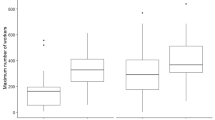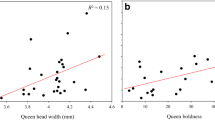Abstract
In social hymenoptera, the reproductive division of labor is often linked to differences in individual body size with the reproductive caste (the queen) being larger than the workers. Likewise, the reproductive potential may vary with size within the worker caste and could affect the evolution of worker size in social insects. Here, we tested the relationship between worker size and reproductive potential in the facultative parthenogenetic ant Cataglyphis cursor. Colonies are headed by a multiply mated queen, but workers can produce gynes (virgin queens) and workers by thelytokous parthenogenesis after the queen’s death. We observed the behaviour of workers (n = 357) until the production of gynes (212 h over 3 months) in an orphaned colony (mated queen not present). The size of workers was measured, and their paternal lineage determined using six microsatellite markers, to control for an effect of patriline. Larger workers were more likely to reproduce and lay more eggs indicating that individual level selection could take place. However, paternal lineage had no effect on the reproductive potential and worker size. From the behavioural and genetic data, we also show for the first time in this species, evidence of aggressive interactions among workers and a potential for nepotism to occur in orphaned colonies, as the five gynes produced belonged to a single paternal lineage.

Similar content being viewed by others
References
Baroni Urbani C, Passera L (1996) Origin of ant soldiers. Nature 383:223
Blatrix R, Jaisson P (2001) Reproductive strategy of the Ponerine ant Gnamptogenys striatula Mayr (Hymenoptera: Formicidae). Sociobiology 37:147–161
Boomsma JJ, Ratnieks FLW (1996) Paternity in eusocial Hymenoptera. Philos Trans R Soc Lond B 351:947–975
Bourke AFG (1988) Worker reproduction in the higher eusocial Hymenoptera. Quart Rev Biol 63:291–311
Bourke AFG, Franks NR (1995) Social evolution in ants. Princeton University Press, Princeton
Brian MV (1953) Brood-rearing in relation to worker number in the ant Myrmica. Physiol Zool 26:355–366
Cagniant H (1976) Distribution, écologie et nid de la fourmi Cataglyphis cursor Fonscolombe Hyménoptères Formicidae. Vie Milieu 26:265–276
Cagniant H (1980a) Etude des stades larvaires, de la lignée des ailes et de la lignée des ouvrières, dans des colonies avec reine et des colonies sans reine chez la fourmi Cataglyphis cursor Fonsc. (H.F.). Bulletin de la Société d’Histoire Naturelle 116:192–206
Cagniant H (1980b) Etude en élevage de la productivité de sociétés avec reine et de sociétés sans reine. Insectes Soc 27:157–174
Cagniant H (1982) La parthénogenèse thélytoque et arrhénotoque chez la fourmi Cataglyphis cursor Fonscolombe (Hymenoptera, Formicidae) étude des œufs pondus par les reines et les ouvrières: Morphologie, devenir, influence sur le déterminisme de la caste reine. Insectes Soc 29:75–188
Cagniant H (1983) La parthénogénèse thélytoque et arrhénotoque des ouvrières de la fourmi Cataglyphis cursor Fonscolombe (Hyménoptères Formicidae) étude biométrique des ouvrières et de leurs potentialités reproductrices. Insectes Soc 30:241–254
Cagniant H (1984) Influence de la reine sur l’apparition des sexués ailés et sur la ponte des ouvrières chez la fourmi Cataglyphis cursor (Fonsc.). Bull Soc Hist Toulouse 120:99–102
Cerdá X (2001) Behavioural and physiological traits to thermal stress tolerance in two Spanish desert ants. Etologia 9:15–27
Cerdá X, Retana J (1997) Links between worker polymorphism and thermal biology in a thermophilic ant species. Oikos 78:467–474
Cerdá X, Retana J, Bosch J, Alsina A (1989) Daily foraginig activity and food collection of the thermophilic ant Cataglyphis cursor (Hymenoptera, Formicidae). Vie Milieu 39:207–212
Clémencet J (2006) Evolution of dispersal and reproductive strategies in the ant Cataglyphis cursor. PhD thesis, Université Paris VI
Clémencet J, Doums C (2007) Habitat-related microgeographic variation of worker size and colony size in the ant Cataglyphis cursor. Oecologia 152:211–218
Clémencet J, Viginier B, Doums C (2005) Hierarchical analysis of population genetic structure in the monogynous ant Cataglyphis cursor using microsatellite and mitochondrial DNA markers. Mol Ecol 14:3735–3744
Cole BJ (1986) The social behavior of Leptothorax allardycei (Hymenoptera, Formicidae): time budgets and the evolution of worker reproduction. Behav Ecol Sociobiol 18:165–173
Dietemann V, Hölldobler B, Peeters C (2002) Caste specialization and differentiation in reproductive potential in the phylogenetically primitive ant Myrmecia gulosa. Insectes Soc 49:289–298
Frumhoff PC, Ward PS (1992) Individual-level selection, colony-level selection and the association between polygyny and worker monomorphism in ants. Am Nat 139:559–590
Gobin B, Ito F (2003) Sumo wrestling in ants: major workers fight over male production in Acanthomyrmex ferox. Naturwissenschaften 90:318–321
Gobin B, Heinze J, Strätz M, Roces F (2003) The energetic cost of reproductive conflicts in the ant Pachycondyla obscuricornis. J Insect Physiol 49:747–752
Hamilton WD (1987) Discriminating nepotism: expectable, common, overlooked. In: Fletcher DJC, Michener CD (eds) Kin recognition in animals. Wiley, New York, NY, pp 417–437
Hartmann A, D’Ettorre P, Jones GR, Heinze J (2005) Fertility signaling—the proximate mechanism of worker policing in a clonal ant. Naturwissenschaften 92:282–286
Heinze J, Hölldobler B (1995) Thelytokous parthenogenesis and dominance hierarchies in the ponerine ant, Platythyrea punctata. Naturwissenschaften 82:40–41
Heinze J, Oberstadt B (1999) Worker age, size and social status in queenless colonies of the ant Leptothorax gredleri. Anim Behav 58:751–759
Heinze J, Trunzer B, Oliveira PS, Hölldobler B (1996) Regulation of reproduction in the ponerine ant, Pachycondyla villosa. J Insect Behav 9:441–450
Heinze J, Foitzik S, Oberstadt B, Ruppell O, Hölldobler B (1999) A female caste specialized for the production of unfertilized eggs in the ant Crematogaster smithi. Naturwissenschaften 86:93–95
Heinze J, Strätz M, Pedersen JS, Haberl M (2000) Microsatellite analysis suggests occasional worker reproduction in the monogynous ant Crematogaster smithi. Insectes Soc 47:299–301
Hölldobler B, Wilson EO (1990) The ants. Springer, Berlin Heidelberg New York
Kaptein N, Billen J, Gobin B (2005) Larval begging for food enhances reproductive options in the ponerine ant Gnamptogenys striatula. Anim Behav 69:293–299
Lenoir A (1986) Eco-Ethologie des populations de la fourmi Cataglyphis cursor. Coll. Nat. CNRS « Biologie des Populations ». Publication Université Lyon I, 645–452
Lenoir A, Querard L, Pondicq N, Berton F (1988) Reproduction and dispersal in the ant Cataglyphis cursor (Hymenoptera, Formicidae). Psyche 95:21–44
McCullagh P, Nelder JA (1989) Generalized Linear Models. Chapman and Hall, London
Michener CD (2000) The bees of the world. Johns Hopkins University, Baltimore, MD
Monnin T, Ratnieks FLW (2001) Policing in queenless ponerine ants. Behav Ecol Sociobiol 50:97–108
Oster GF, Wilson EO (1978) Caste and ecology in the social insects. Princeton University Press, Princeton, NJ
Pearcy M, Aron S (2006) Local resource competition and sex ratio in the ant Cataglyphis cursor. Behav Ecol 17:569–574
Pearcy M, Aron S, Doums C, Keller L (2004a) Conditional use of sex and parthenogenesis for worker and queen production in ants. Science 306:1780–1783
Pearcy M, Clémencet J, Chameron S, Aron S, Doums C (2004b) Characterization of nuclear DNA microsatellite markers in the ant Cataglyphis cursor. Mol Ecol Notes 4:642–644
Pearcy M, Hardy O, Aron S (2006) Thelytokous parthenogenesis and its consequences on inbreeding in an ant. Heredity 96:377–382
Ravary F, Jaisson P (2004) Absence of individual sterility in thelytokous colonies of the ant Cerapachys biroi Forel (Formicidae, Cerapachyinae). Insectes Soc 51:67–73
Retana J, Cerdá X (1990) Social-organization of Cataglyphis cursor ant colonies (Hymenoptera, Formicidae)—interspecific, and intraspecific comparisons. Ethology 84:105–122
Stearns SC (1992) The Evolution of Life Histories. Oxford University Press, New-York
Tsuji K (1995) Reproductive conflicts and levels of selection in the ant Pristomyrmex pungens: contextual analysis and partitioning of covariance. Am Nat 146:586–607
Ward PS (1997) Ant soldiers are not modified queens. Nature 385:494–495
Wiernasz DC, Cole BJ (2003) Queen size mediates queen survival and colony fitness in harvester ants. Evolution 57:2179–2183
Acknowledgements
We thank L. Cournault and B. Viginier for their valuable help during the field work, H. Magalon, T. Monnin, C. Tirard, C.W. Torres and E. van Wilgenburg for their helpful comments on the manuscript. This work was supported by a French research grant “Action concertée incitative jeunes chercheurs 2001” ACI N°5183. The experiments performed in this study comply with the current laws of France.
Author information
Authors and Affiliations
Corresponding author
Rights and permissions
About this article
Cite this article
Clémencet, J., Rome, Q., Fédérici, P. et al. Aggressions and size-related fecundity of queenless workers in the ant Cataglyphis cursor . Naturwissenschaften 95, 133–139 (2008). https://doi.org/10.1007/s00114-007-0304-5
Received:
Revised:
Accepted:
Published:
Issue Date:
DOI: https://doi.org/10.1007/s00114-007-0304-5




